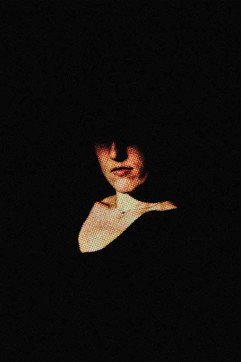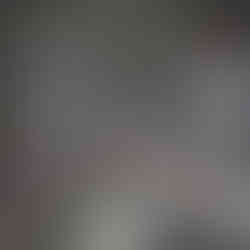HAOCHEN HE
- ARTISTIC HUB MAGAZINE

- Oct 20
- 7 min read
Where Structure Breaks, Meaning Begins
Architecture, art, and photography merge into a single language in his work, one that is precise, thoughtful, and deeply personal.
He is an architect and visual artist whose work explores the boundaries between space and identity. Born in China and currently based in the United States, he graduated from Cornell University and developed his career through large-scale architectural projects. Yet beneath the technical precision of his education, there lies a profoundly personal way of seeing the world, one in which structure turns into inquiry and space becomes a way of thinking. His artistic practice unfolds at the intersection of architecture, photography, and visual design. In series such as 404 Stair Not Found, Dot Matrix Identity, and Continuum of Comics, Haochen explores the moments when functionality dissolves into symbolism. A fragment, an error or a digital interruption in his work is never the end of structure but the beginning of new meaning. Through this conversation, he opens a window into a world where architecture reflects the human mind and art becomes a way of preserving what often remains unspoken in everyday life.

Your project 404 Stair Not Found treats the staircase not only as an architectural element but also as a metaphor for error and rupture. What first led you to see the staircase in this way, and how did the project evolve from that idea?
The idea first emerged while I was developing an architectural study that explored circulation and movement through digital modeling. I became fascinated by the concept of the digital twin: a system designed to replicate and predict physical performance with perfect precision. While working within this framework, I started to question what happens when such systems fail or lose connection to the realities they are meant to mirror. This led me to the staircase, an element that embodies transition and physical control. Observing unfinished or disconnected structures, where stairs no longer lead anywhere, I began to see them as moments when architecture exposes its own limits, revealing a psychological dimension beneath its order.
As the project evolved, the staircase shifted from being a functional element to becoming a conceptual framework. Initially, it existed as a spatial experiment within my architectural thesis, examining movement and access through virtual simulations. Gradually, the focus moved from representation to rupture. I began translating these studies into models, photographs, and digital compositions that emphasized interruption and ambiguity. What started as an exploration of architectural precision evolved into a reflection on how systems, both digital and human, fragment, distort, and persist, in their own unfinished states.
404 Stair Not Found
In the series Dot Matrix Identity, figures appear through concealment and partial presence. How did you develop this concept, and when does concealment move beyond an aesthetic gesture to become an act of resistance or a way of addressing identity?
The concept began during a conversation with one of the models I worked with. I often talk with collaborators before photographing to build a sense of trust and understanding. During one of these conversations, the model mentioned feeling tired of always being looked at. That simple statement stayed with me. It made me think about how visibility can be both empowering and exhausting, how showing oneself can sometimes mean losing control over one’s image. From this moment, the idea of concealment emerged as a way to question what it means to be seen.
As the project developed, I began to explore hiding not as withdrawal but as a deliberate act of self-definition. Each figure in the series exists between presence and disappearance, reflecting the complexity of identity in contemporary culture. In an age defined by exposure and self-presentation, concealment becomes a form of agency, a way to reclaim autonomy over how identity is shaped, shared, or withheld.
Dot Matrix Identity
Continuum of Comics combines the visual language of comics with digital glitch effects. What inspired you to bring these two worlds together, and how does the series reflect your view of contemporary identity?
Images today do not stay still. They are copied, filtered, and remade until the line between original and imitation disappears. I found myself drawn to this instability, to how visual systems create order only to expose their own fragility. Both comics and digital glitches embody this paradox. Comics follow a strict visual rhythm, yet their meaning depends on what happens between frames. Glitches, on the other hand, interrupt and reveal the hidden logic of the digital. Bringing the two together allowed me to explore how clarity and distortion coexist in the way we construct identity.
My background in architecture naturally informed this process: the way I think about frames, rhythm, and spatial logic translated into how I arranged panels and visual intervals within each composition. Comics became a perfect vehicle for this dialogue between control and interruption.
Both comics and glitches offer contrasting ways of shaping identity. The comic portrait idealizes and simplifies the figure, turning it into a clear visual symbol, while the glitch disrupts that clarity, revealing the fractures hidden within representation. Their coexistence mirrors how identity today is assembled from edited images, online profiles, and algorithmic reflections. Versions of ourselves are constantly reshaped and reinterpreted. Through this dialogue, I reflect on how the human image survives within these systems, suspended between authenticity and simulation.
Continuum of Comics
You work on large-scale architectural projects for a wide audience, while your artistic practice often explores silence, absence, and intimate moments. How do these two experiences interact, and in what ways does one influence the other?
Working in architecture has shown me that even within collective environments, intimacy can emerge through design. Large-scale projects often serve many people, but within these public systems, there are moments of retreat, such as private rooms, a speakeasy, or quiet thresholds that allow for separation and reflection. I am drawn to these transitions between openness and seclusion, between what is shared and what is held back. My artistic work grows from this tension, translating spatial ideas of concealment into visual and psychological form.
Architecture and art continually inform each other. Architecture teaches me to think through structure and rhythm, to understand how form shapes experience. Art reminds me that even in large collective spaces, emotion must remain present so that design does not become detached from the human experience. Conversely, architecture gives my art a sense of clarity and spatial logic. Each practice refines the other, creating a dialogue between emotion and precision, between the visible structure and the inner life it contains.

When you move from architecture to photography, how does your way of seeing change? Do you still approach the work with an "architectural framework," or does photography allow a different kind of focus and freedom?
When I first began taking photographs, architecture was often my main subject. I approached it through a traditional architectural lens, thinking in lines, grids, and facades, focusing on balance, proportion, and spatial order. Over time, I realized that architecture is not only a static art but also one shaped by movement. Concrete and steel may remain still, but light, atmosphere, and human presence continuously transform what we see.
This realization changed my methods before it changed my subjects. I began to loosen the frame by shooting off-axis, working handheld, varying focal lengths, and using shallow depth of field and selective focus. I recorded light drift with long exposures, welcomed motion blur, layered reflections, and the foreground occlusion, and waited for bodies to enter the frame. In editing, I built sequences to suggest rhythm and story. These approaches now extend to portraits, landscapes, and natural scenes, and they also inform my architectural photographs, where I aim to convey how space breathes and how time and people move through it.
Error, glitch, and incompleteness in your work are not obstacles but sources of new meaning. Could you share an example of a time when such an "error" became a discovery and led to a new series?
When I think about how error or incompleteness becomes meaningful in my work, I often return to an experience from a housing project in Chongqing. The tower had been left unfinished after the developer went bankrupt; families had already begun to occupy it, by building makeshift homes within its exposed concrete frame. I approached the site with the intention of completing what was missing, but observing how residents built kitchens from leftover debris and used curtains to divide space changed my understanding of failure. Their actions transformed the unfinished into something living. I began to see the project not as a problem to fix but as a process to continue. The design grew from what already existed, using fragments as a foundation for renewal. That experience taught me that incompleteness can be a form of resilience rather than a mark of deficiency.
A similar realization occurred in a memorial project when a hand-cast concrete model unexpectedly cracked as it dried. Instead of discarding it, I adjusted the lighting so the fissures became part of the composition. What began as a mistake revealed a new way of seeing structure and vulnerability. These moments, from large-scale housing to small-scale models, helped me understand that what we call error is often an opening. It invites new forms of adaptation and meaning, allowing each project to remain open-ended rather than resolved.
Looking back at the series you have created to date, which work feels closest to your personal philosophy, and what would you like the audience to take away from encountering your art?
Among my works, 404 Stair Not Found feels closest to my personal philosophy. It began as an exploration of spatial systems but became a reflection on how absence itself can be constructed. The staircase, usually a tool for movement, was reimagined as a space that leads nowhere, questioning the logic of progress and completion that define both architecture and digital culture. In this work, architecture and art meet: one is where I came from, and the other is where I question the meaning of that foundation. Through this intersection, I discovered that the discipline of structure could also open a path toward uncertainty, vulnerability, and imagination.
What I hope viewers experience is a moment of recognition, when the work quietly resonates with something within their own lives. Some may connect to it as a personal metaphor, while others might see it as a reflection on structural theory. My intention is not to impose a direct interpretation, but to create a space for reflection, where structure and emotion can coexist. I want the audience to feel that each form carries both precision and fragility, and that understanding art can arise through empathy as much as analysis.

Square Exit
Haochen He’s artistic work reveals how fluid the boundary between the technical and the emotional can be. Each of his compositions grows from a deep attention to detail and a willingness to question what is familiar. Through this process, architecture becomes a mirror of thought, and art a means of understanding the spaces that shape us. His works are not records of reality but traces of exploration, a way to understand how material, form, and idea can coexist on the same plane. This pursuit makes his art open, reflective, and profoundly contemporary.
HAOCHEN HE DESIGN































